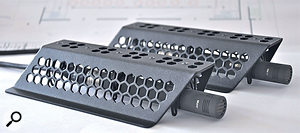Anyone who's used a microphone will be aware of the need to place the mic such that the balance between direct and reflected sound provides the desired perspective. If the reflected sound is particularly strong, it can cause coloration problems as a result of comb filtering, and a common solution is to use a 'boundary layer' or 'pressure zone' mic: the mic is placed in very close proximity to the reflecting surface, so it no longer receives a strong delayed reflection and only the direct sound is captured.
 Most manufacturers offer one or two boundary mics, but high-quality options tend to be too expensive to justify if they're to be used infrequently. I've often resorted to a low-cost 'Heath Robinson' approach of inserting a small-diaphragm omnidirectional capacitor mic into a long foam windshield intended for a shot-gun microphone, and taping it to the floor. It works, and the foam provides some vibration isolation, but the mic could easily be stepped on!
Most manufacturers offer one or two boundary mics, but high-quality options tend to be too expensive to justify if they're to be used infrequently. I've often resorted to a low-cost 'Heath Robinson' approach of inserting a small-diaphragm omnidirectional capacitor mic into a long foam windshield intended for a shot-gun microphone, and taping it to the floor. It works, and the foam provides some vibration isolation, but the mic could easily be stepped on!
German manufacturers Maier Sound have developed a neat new product, the Turtle, which addresses precisely this issue. This patented device is a 'boundary layer adaptor' that will convert any small-diaphragm mic with a body diameter of 19-21 mm into a boundary mic, while providing extremely robust protection and integrated vibration isolation.
Basically, the Turtle is very strong steel plate, painted in a tough, matt-black finish (other colours are available to order) and folded into an inverted U-shape, with numerous hexagonal holes stamped through all three surfaces. Non-slip silicon pads are fixed on to the base to prevent sliding, and I'm told that future batches will have pre-drilled holes to allow semi-permanent fixing with screws. The adaptor is seriously strong, and I wouldn't be surprised if it could withstand being driven over (I haven't tested that hypothesis!). Hanging from the 'top' of the Turtle (assuming placement on the floor) are three Rycote 'Lyre' suspensions, two to support any appropriately sized mic, and another for the cable. This combination provides a high-degree of isolation from conducted noise and vibration. In this way, the mic capsule is held just a few millimetres above the floor.
In tests, the Turtle worked as promised and produced very good results. Fitting any suitable mic was trivially simple, although I wondered if perhaps the mic should actually be housed the other way around, so that the chamfered side panels provide more horizontal protection for the capsule and less vertical sound obstruction. If required, this can be achieved easily by relocating the Rycote Lyres, which only involves undoing some Allen bolts. There are five mounting points for the three supplied Lyre clips, allowing alternative Lyre spacing for different length mics, which is a thoughtful feature.
The asking price might initially sound expensive for what is, in essence, a chunk of metal. However, the sound quality can be as good as the mic you slip into it, and if you already own decent mics, the cost is much less than acquiring dedicated, pro-quality boundary mics. Buying a suitable omni mic and the Turtle will also give you greater versatility for a similar price... all of which makes the Turtle look like an attractive solution to this problem. Hugh Robjohns
